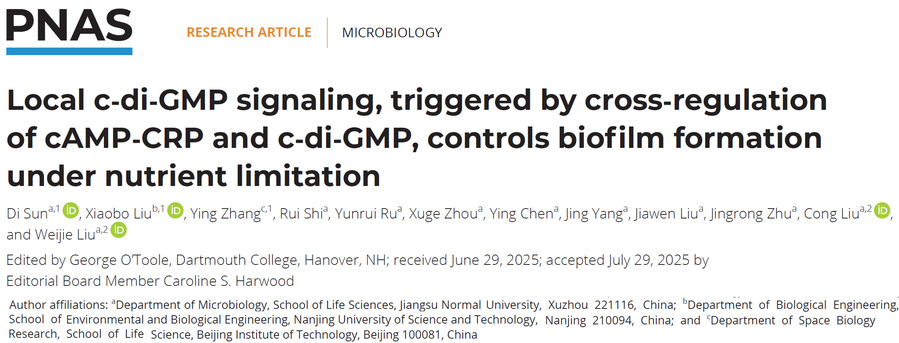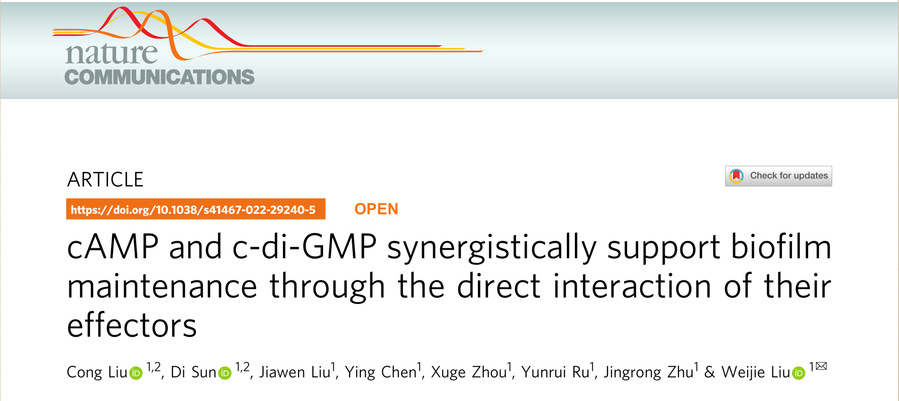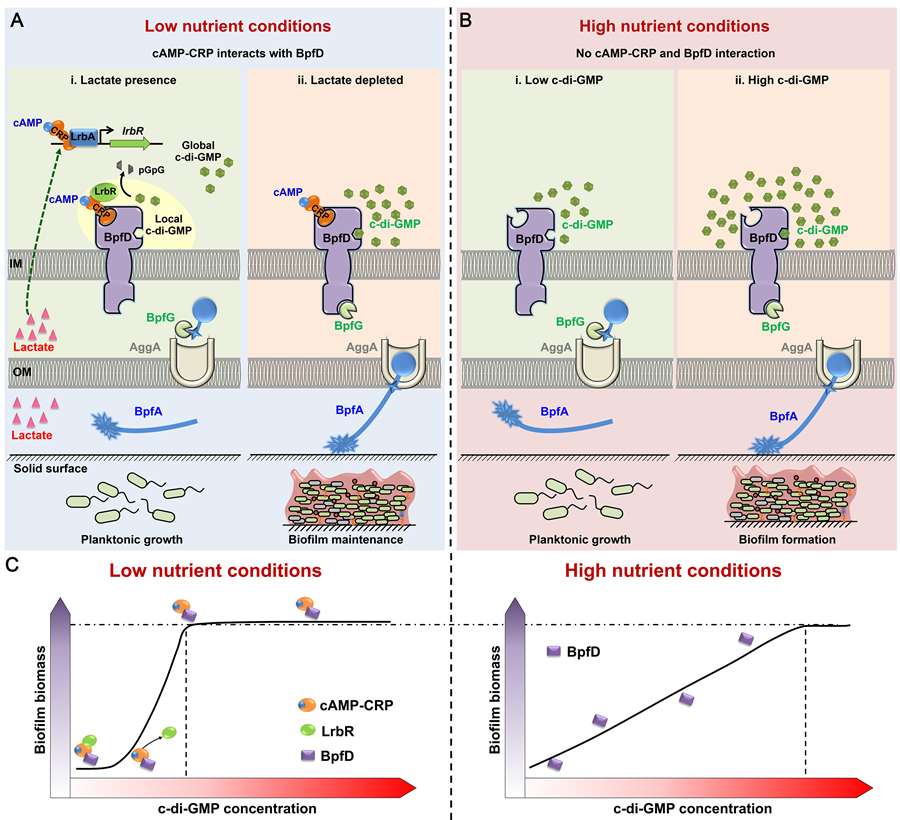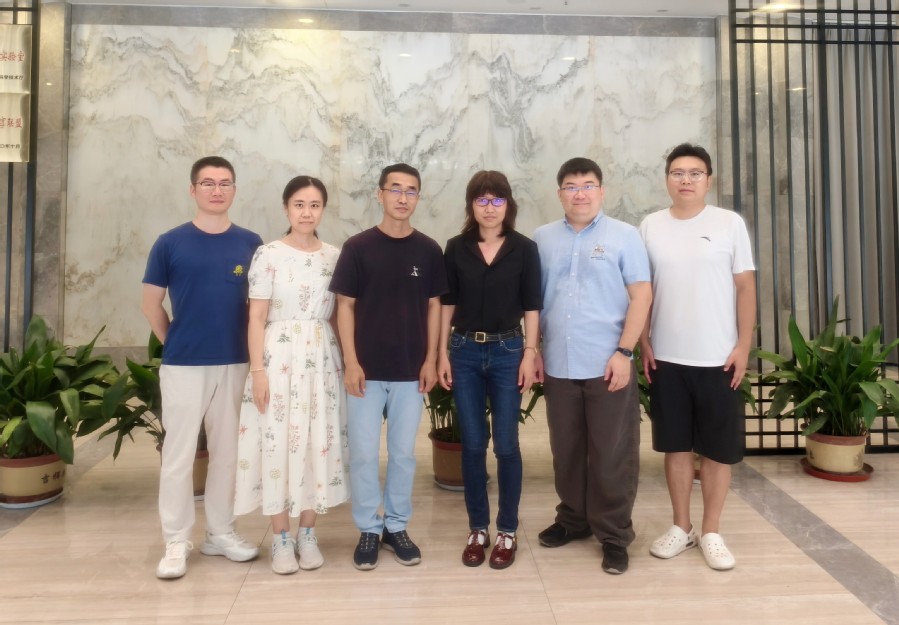Liu Weijieand Liu Cong’s team of the School of Life Sciences has published a long research paper titled “Local c-di-GMP signaling, triggered by cross-regulation of cAMP-CRP and c-di-GMP, controls biofilm formation under nutrient limitation” inPNAS, a natural index journal. Jiangsu Normal University (JSNU) is thefirst affiliation. Sun Di, Associate Professor in the School of Life Sciencesat JSNU, Professor Liu Xiaobo from Nanjing University of Technology and Professor Zhang Ying from Beijing University of Technology are the co-first authors. Five graduate students including Shi Rui, Ru Yunrui, Zhou Xuge, Chen Ying, Yang Jing, as well as two teachers, Liu Jiawen and Zhu Jingrong are research participants. Associate Professor Liu Cong and Professor Liu Weijie are the corresponding authors.
Bacteria have several nucleotide second messengers, most of which act as global regulators to control a wide range of bacterial physiological processes. Studies usually focus on a single second messenger, and the mechanisms and physiological significance of the cross-regulation between different nucleotide second messengers are often unclear. Here, we show that Shewanella putrefaciens can form biofilms in both nutrient-rich and nutrient-poor media. While both are controlled by c-di-GMP, the regulatory models differ. Under low nutrient conditions, cross-regulation of cAMP-CRP and c-di-GMP occurs at the transcriptional and posttranslational levels, thereby controlling biofilm development. During the early stages of biofilm development, cAMP-CRP directly promotes the transcription of a PDE gene, lrbR, by LrbA. Additionally, cAMP-CRP recruits LrbR to BpfD to suppress early biofilm formation via LrbR-dependent local degradation of c-di-GMP. Finally, as intracellular LrbR levels decrease, cAMP-CRP-BpfD enables a rapid shift to biofilm development and supports biofilm maintenance. Under high nutrient conditions, this cross-regulation does not occur, resulting in a positive correlation between global c-di-GMP levels and biofilm biomass. The identification of distinct modes of biofilm regulation in different nutrients will provide a theoretical basis for future targeted control of biofilm formation in different nutrient environments.

Nucleotide second messengers, such as cAMP and c-di-GMP, regulate many physiological processes in bacteria, including biofilm formation. There is evidence of cross-talk between pathways mediated by c-di-GMP and those mediated by the cAMP receptor protein (CRP), but the mechanisms are often unclear. Here, we show that cAMP-CRP modulates biofilm maintenance in Shewanella putrefaciens not only via its known effects on gene transcription, but also through direct interaction with a putative c-di-GMP effector on the inner membrane, BpfD. Binding of cAMP-CRP to BpfD enhances the known interaction of BpfD with protease BpfG, which prevents proteolytic processing and release of a cell surface-associated adhesin, BpfA, thus contributing to biofilm maintenance. Our results provide evidence of cross-talk between cAMP and c-di-GMP pathways through direct interaction of their effectors, and indicate that cAMP-CRP can play regulatory roles at the post-translational level.
(https://www.nature.com/articles/s41467-022-29240-5)


Pattern for the regulation under different nutrient conditions
The research is funded by National Natural Science Foundation of China, Jiangsu Provincial Natural Science Foundation, Scientific Experiment Project of China Space Station, Natural Science Foundation of Xuzhou, etc.

The group photo of Liu Weijieand Liu Cong’s team
Liu Cong, an associate professor and master’s supervisor, is mainly engaged in molecular mechanism researchonbacterial biofilm. He presides over 1 general programof National Natural Science Foundation of Chinaand 1 project funded by the National Science Fund for Distinguished Young Scholars, 1 general programof Jiangsu Provincial Natural Science Foundation, publishes 25 SCI papers in journals such as Nature Communications, PNAS, Applied and Environmental Microbiology, and obtained 2 invention patents.
Liu Weijie,a professor and doctoral supervisor, has been selected into young and middle-aged academic leaders of Jiangsu Province “333 Project”, Jiangsu Province “Six Talents Peaks” High-Level Talents, outstanding young backbone teachers of Jiangsu Province “Qing Lan Project”, and he is the winner of Xuzhou “Top TenYouth Science and Technology Award”. In addition, he won the second prize for the Ministry of Education’s Science and Technology Progress Award and the Third Prize for Science and Technology Achievements of Jiangsu Universities. He also presides over projects of the National Space Science and Application, 2 general programs of National Natural Science Foundation of China, 1 project funded by National Science Fund for Distinguished Young Scholars, 5 provincial and ministerial projects, and 4 municipal projects. He has published more than 40 SCI papers in journals such as Nature Communications, Nature Chemical Biology, Microbiome and PNAS. Additionally, he has obtained 7 invention patents as the first patentee.
Paper Link:https://doi.org/10.1073/pnas.2516964122
